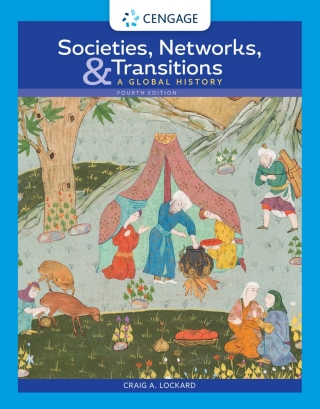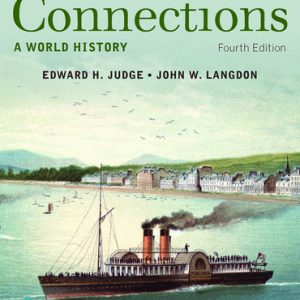Buy Societies, Networks, and Transitions: A Global History, 4th Edition PDF ebook by author Craig A. Lockard – published by Cengage Learning in 2021 and save up to 80% compared to the print version of this textbook. With PDF version of this textbook, not only save you money, you can also highlight, add text, underline add post-it notes, bookmarks to pages, instantly search for the major terms or chapter titles, etc.
You can search our site for other versions of the Societies, Networks, and Transitions: A Global History, 4th Edition PDF ebook. You can also search for others PDF ebooks from publisher Cengage Learning, as well as from your favorite authors. We have thousands of online textbooks and course materials (mostly in PDF) that you can download immediately after purchase.
Note: e-textBooks do not come with access codes, CDs/DVDs, workbooks, and other supplemental items.
eBook Details:
Full title: Societies, Networks, and Transitions: A Global History, 4th Edition
Edition: 4th
Copyright year: 2021
Publisher: Cengage Learning
Author: Craig A. Lockard
ISBN: 9780357365472, 9780357365472
Format: PDF
Description of Societies, Networks, and Transitions: A Global History, 4th Edition:
Exploring history in global framework, Lockard’s SOCIETIES, NETWORKS, AND TRANSITIONS: A GLOBAL HISTORY, Fourth Edition, combines the accessibility and cultural richness of a regional approach with the rigor of comparative scholarship. Emphasizing culture, social change, gender issues, economic patterns, science and religion, it helps you unravel the connections, encounters, cooperation and conflicts of world and regional history. The author includes profiles of individuals from various walks of life as well as highlights social life and cultural artifacts such as music, literature and art. Extensively revised, the text incorporates recent scholarship throughout, examines various debates among historians and explains how historians use original documents. Insightful questions help you reflect on the historical significance of text material — and how it relates to you.Important Notice: Media content referenced within the product description or the product text may not be available in the ebook version.
Table of Contents of Societies, Networks, and Transitions: A Global History, 4th Edition PDF ebook:
Brief ContentsContentsMapsFeaturesPrefaceAbout the AuthorNote on Spelling and UsageIntroducing World HistoryPart I: Ancient Foundations of World History, to ca. 600 BCEChapter 1: The Origins of Human Societies, to ca. 2000 BCE1-1 Prehistory: The Cosmos, Earth, and the Roots of Humanity1-2 The Odyssey of Early Human Societies1-3 The Agricultural Transformation, 10,000-4000 BCE1-4 The Emergence of Cities and StatesChapter SummaryKey TermsChapter 2: Ancient Societies in Mesopotamia, India, and Central Asia, 5000-600 BCE2-1 Early Mesopotamian Urbanized Societies, to 2000 BCE2-2 Later Mesopotamian Societies and Their Legacies, 2000-600 BCE2-3 The Earliest Indian and Central Asian Societies, 6000-1500 BCE2-4 The Aryans and a New Indian Society, 1500-600 BCEChapter SummaryKey TermsChapter 3: Ancient Societies in Africa and the Mediterranean, 5000-600 BCE3-1 The Rise of Egyptian Society3-2 Egyptian Society, Economy, and Culture3-3 Ancient Sub-Saharan African Societies3-4 Early Societies and Networks of the Eastern MediterraneanChapter SummaryKey TermsChapter 4: Around the Pacific Rim: Eastern Eurasia and the Americas, 5000-600 BCE4-1 The Formation of Chinese Society, 6000-1750 BCE4-2 The Reshaping of Ancient Chinese Society, 1750-600 BCE4-3 Ancient Southeast and Northeast Asians4-4 Ancient AmericansChapter SummaryKey TermsPart II: The Classical Societies and Their Legacies, ca. 600 BCE-ca. 600 CEChapter 5: Classical Societies in Southern and Central Asia, 600 BCE-600 CE5-1 The Transformation of Indian Society, Religion, and Politics5-2 South and Central Asia after the Mauryas5-3 The Gupta Age in India5-4 The Development of Southeast Asian SocietiesChapter SummaryKey TermsChapter 6: Eurasian Connections and New Traditions in East Asia, 600 BCE-600 CE6-1 Changing China and Axial Age Thought, 600-221 BCE6-2 Chinese Imperial Systems and the World6-3 China after the Han Empire: Continuity and Change6-4 Korea, Japan, and East Asian NetworksChapter SummaryKey TermsChapter 7: Western Asia, the Eastern Mediterranean, and Regional Systems, 600-200 BCE7-1 The Persians and Their Empire7-2 The Rise and Flowering of the Greeks7-3 Greeks, Persians, and the Regional System7-4 The Hellenistic Age and Its Afro-Eurasian LegaciesChapter SummaryKey TermsChapter 8: Empires, Networks, and the Remaking of Europe, North Africa, and Western Asia, 500 BCE-608-1 Etruscans, Carthage, Egypt, and the Roman Republic8-2 The Rise and Decline of Imperial Rome8-3 Christianity: From Western Asian Sect to Transregional Religion8-4 Revival in the East: Byzantines, Persians, and ArabsChapter SummaryKey TermsChapter 9: Classical Societies and Regional Networks in Africa, the Americas, and Oceania, 600 BCE-69-1 Classical States and Connections in Northeast Africa9-2 The Blossoming of West and Bantu Africa9-3 Classical Societies and Networks in the Americas9-4 Populating the Pacific: Australian and Island SocietiesChapter SummaryKey TermsPart III: Encounters and Transformations in the Intermediate Era, ca. 600-1500Chapter 10: The Rise, Power, and Connections of the Islamic World, 600-150010-1 Early Islam: The Origins and Spread of a Continuous Tradition10-2 Early Islamic States and Empires10-3 Cultural Hallmarks of Islam: Theology, Society, and Learning10-4 Globalized Islam and Middle Eastern Political ChangeChapter SummaryKey TermsChapter 11: East Asian Traditions, Transformations, and Eurasian Encounters, 600-150011-1 Tang China: The Hub of the East11-2 Song China and Commercial Growth11-3 Mongol Conquest, Chinese Resurgence, and Eurasian Connections11-4 Cultural Adaptation in Korea and JapanChapter SummaryKey TermsChapter 12: Expanding Horizons in Africa and the Americas, 600-150012-1 Diverse African States and Peoples12-2 African Societies, Thought, and Economies12-3 American Societies in Transition12-4 The American Empires and Their ChallengesChapter SummaryKey TermsChapter 13: South Asia, Central Asia, Southeast Asia, and Afro-Eurasian Connections, 600-150013-1 Hinduism, Buddhism, and South Asian Society13-2 The Coming of Islam to India and Central Asia13-3 Cultural Adaptation and Kingdoms in Southeast Asia13-4 Buddhist, Confucian, and Islamic Southeast Asian SocietiesChapter SummaryKey TermsChapter 14: Christian Societies in Medieval Europe, Byzantium, and Russia, 600-150014-1 Forming Christian Societies in Western Europe14-2 Medieval Societies, Thought, and Politics14-3 Eastern Europe: Byzantines, Slavs, and Mongols14-4 Late Medieval Europe and the Roots of ExpansionChapter SummaryKey TermsPart IV: Connecting the Early Modern World, 1450-1750Chapter 15: Global Connections and the Remaking of Europe, 1450-175015-1 Overseas Expansion and Capitalism15-2 The Renaissance and Reformation15-3 Changing States and Politics15-4 The Transformation of Cultures and SocietiesChapter SummaryKey TermsChapter 16: New Challenges for Africa and the Islamic World, 1450-175016-1 Sub-Saharan African Societies16-2 Early European Imperialism and the Trans-Atlantic Slave Trade16-3 The Ottomans and Islamic Imperial Revival16-4 Persia, Morocco, and Central AsiaChapter SummaryKey TermsChapter 17: Americans, Europeans, Africans, and New Societies in the Americas, 1450-175017-1 Early American-European-Pacific Encounters17-2 The European Conquest of the Americas17-3 The Consequences of American Colonization17-4 New Economies, Slavery, and the Atlantic SystemChapter SummaryKey TermsChapter 18: South Asia, Southeast Asia, and East Asia: Triumphs and Challenges, 1450-175018-1 Mughal India, South Asia, and New Encounters18-2 Southeast Asia and Global Connections18-3 Early Modern China and New Challenges18-4 Continuity and Change in Korea and JapanChapter SummaryKey TermsPart V: Global Imbalances in the Modern World, 1750-1945Chapter 19: Modern Transitions: Revolutions, Industries, Ideologies, Empires, 1750-191419-1 The Age of Revolution19-2 The Industrial Revolution and Economic Growth19-3 Nationalism, Liberalism, and Socialism19-4 The Resurgence of Western ImperialismChapter SummaryKey TermsChapter 20: Changing Societies in Europe, the Americas, and Oceania, 1750-191420-1 The Reshaping of European Societies20-2 The Rise of the United States20-3 Latin America and the Caribbean in the Global System20-4 New Societies in Canada and the Pacific BasinChapter SummaryKey TermsChapter 21: Africa, the Middle East, and Imperialism, 1750-191421-1 The Colonization of Sub-Saharan Africa21-2 The Colonial Reshaping of Sub-Saharan Africa21-3 Imperialism, Reform, and the Middle Eastern Societies21-4 Middle Eastern Thought and CultureChapter SummaryKey TermsChapter 22: South Asia, Southeast Asia, and Colonization, 1750-191422-1 Forming British India22-2 The Reshaping of Indian Society22-3 Southeast Asia and Colonization22-4 The Reshaping of Southeast AsiaChapter SummaryKey TermsChapter 23: East Asia and the Russian Empire Face New Challenges, 1750-191423-1 The Zenith and Decline of Qing China23-2 From Imperial to Republican China23-3 The Remaking of Japan and Korea23-4 Russia’s Eurasian EmpireChapter SummaryKey TermsChapter 24: World Wars, European Revolutions, and Global Depression, 1914-194524-1 The Roots and Course of World War I24-2 The Revolutionary Path to Soviet Communism24-3 The Interwar Years and the Great Depression24-4 The Rise of Fascism and the Renewal of Conflict24-5 World War II: A Global TransitionChapter SummaryKey TermsChapter 25: Imperialism and Nationalism in Asia, Africa, and Latin America, 1914-194525-1 Western Imperialism and Its Challengers25-2 Nationalism and Communism in China25-3 British Colonialism and the Indian Response25-4 Nationalist Stirrings in Southeast Asia and Sub-Saharan Africa25-5 Remaking the Middle East and Latin AmericaChapter SummaryKey TermsPart VI: Global System: Interdependence and Conflict in the Contemporary World, since 1945Chapter 26: The Remaking of the Global System, since 194526-1 Decolonization, New States, and the Global System26-2 Cold War, Hot Wars, and World Politics26-3 Globalizing Economies, Underdevelopment, and Environmental Change26-4 New Global Networks and Their ConsequencesChapter SummaryKey TermsChapter 27: East Asian Resurgence, since 194527-1 Mao’s Revolutionary China27-2 Chinese Modernization27-3 The Remaking of Japan27-4 The Little Dragons in the Asian ResurgenceChapter SummaryKey TermsChapter 28: Rebuilding Europe and Russia, since 194528-1 Western Europe: Revival and Unity28-2 Western European Societies and Cultures28-3 Communism in the Soviet Union and Eastern Europe28-4 Communist Collapse: A New Russia and EuropeChapter SummaryKey TermsChapter 29: The Americas and the Pacific Basin: New Roles in the Contemporary World, since 194529-1 The United States as a Superpower29-2 The Changing Societies of North America and the Pacific Basin29-3 Political Change in Latin America and the Caribbean29-4 Changing Latin American and Caribbean SocietiesChapter SummaryKey TermsChapter 30: The Middle East, Sub-Saharan Africa, and New Conflicts in the Contemporary World, since 30-1 The Middle East: New Nations and Old Societies30-2 Change and Conflict in the Middle East30-3 Political Change in Sub-Saharan Africa30-4 African Economies, Societies, and CulturesChapter SummaryKey TermsChapter 31: South Asia, Southeast Asia, and Global Connections, since 194531-1 The Reshaping of South Asia31-2 South Asian Politics and Societies31-3 Revolution, Decolonization, and New Nations in Southeast Asia31-4 Tigers, Politics, and Changing Southeast Asian SocietiesChapter SummaryKey TermsIndex





